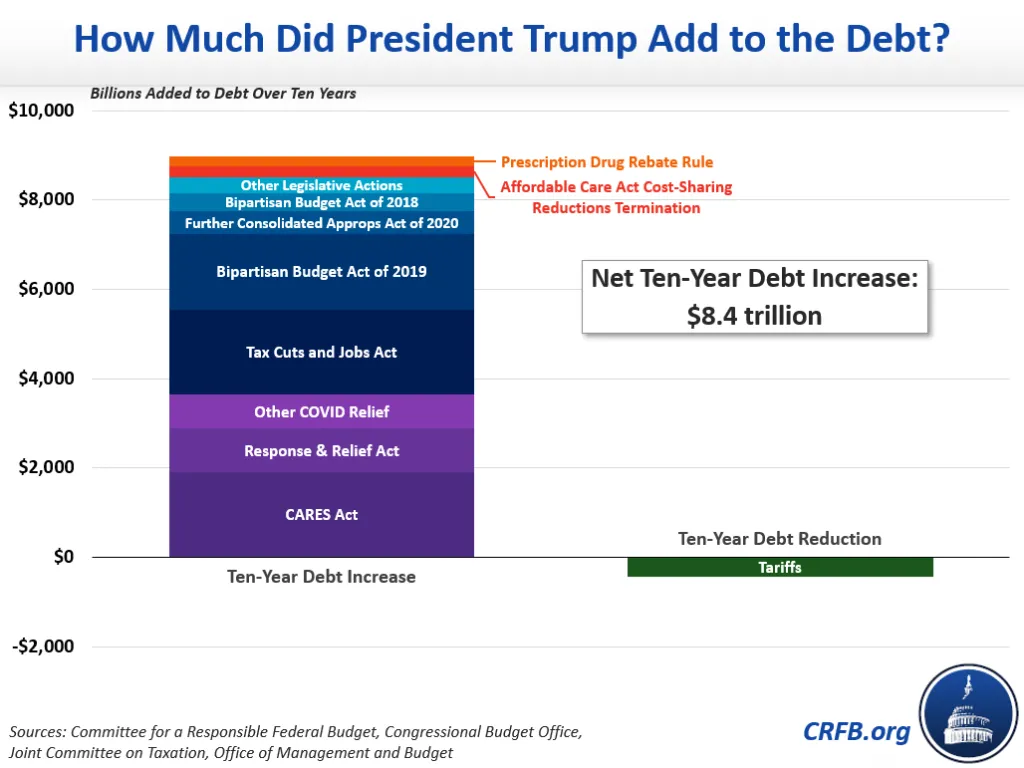How Much Did President Trump Add to the Debt?
Note: We published a more comprehensive, up-to-date comparison analysis of the amount of new ten-year borrowing approved by both Presidents Trump and Biden.
In the recent GOP primary presidential debate, former United Nations Ambassador Nikki Haley claimed that President Trump added $8 trillion to the national debt while Florida Governor Ron DeSantis said that President Trump added $7.8 trillion to the debt. These statements are true, depending on how you measure additions to the debt. We estimate the ten-year cost of the legislation and executive actions President Trump signed into law was about $8.4 trillion, with interest.
It’s also the case that the government accumulated $7.8 trillion of gross federal debt while President Trump was in office, though much of this is unrelated to President Trump’s actions.
| US Budget Watch 2024 is a project of the nonpartisan Committee for a Responsible Federal Budget designed to educate the public on the fiscal impact of presidential candidates’ proposals and platforms. Through the election, we will issue policy explainers, fact checks, budget scores, and other analyses. We do not support or oppose any candidate for public office. |
There are at least two ways to measure how much President Trump added to the debt – though coincidentally they lead to similar conclusions of about $8 trillion.
One way to measure how much President Trump borrowed is by estimating the debt accumulated over his presidency. Over the course of President Trump’s four years in office, the gross national debt grew from $19.95 trillion to $27.75 trillion – a $7.8 trillion increase (debt held by the public – the more economically-meaningful measure of debt – grew by $7.2 trillion over this period). However, much of this borrowing was due to policies put in place before President Trump took office or due to unexpected changes in circumstance. Debt was already projected to grow by about $3 trillion for the four years of his term when President Trump took office, and some of the additional debt accrued was also the direct result of the COVID-19 pandemic and recession. It’s also important to note that the government was holding an unusually large $1.6 trillion in cash when President Trump left office, which inflated the growth in debt relative to the deficit run during his time in office.
A better way to measure how much President Trump added to the debt is to evaluate the ten-year debt impact of the laws and executive orders he signed. We estimate that those added a combined $8.4 trillion to the debt over a ten-year period – consistent with Haley’s claim.
On net, almost all of the $8.4 trillion in ten-year debt approved by Trump came in the form of legislation, with costly executive actions largely offset by a unilateral expansion of tariffs. It included $8.8 trillion of net increases in the debt and $445 billion of net reductions. $7.3 trillion represents an increase in primary deficits, and $1 trillion comes from interest costs.

Of the $8.4 trillion President Trump added to the debt, $3.6 trillion came from COVID relief laws and executive orders, $2.5 trillion from tax cut laws, and $2.3 trillion from spending increases, with the remaining executive orders having costs and savings that largely offset each other.
The largest bills include $1.9 trillion from the 2020 CARES Act, another $1.9 trillion of ten-year borrowing from the 2017 Tax Cuts and Jobs Act, and a further $2.1 trillion of borrowing from the Bipartisan Budget Acts of 2018 and 2019, which mainly increased discretionary spending. The bipartisan Further Consolidated Appropriations Act of 2020 enabled an additional $500 billion of borrowing, mainly from the repeal of various Affordable Care Act (ACA) taxes and other bipartisan tax cuts. Other significant legislation added a combined $350 billion to the deficit.
In terms of executive actions, President Trump’s unilateral expansion of various tariffs raised about $445 billion over ten years, largely offsetting the cost of other actions such as the termination of the ACA’s cost-sharing reductions funding and a prescription drug rebate rule (which was ultimately repealed).
How Much Did President Trump Add to the Debt?
| Legislation/Executive Action | Ten-Year Cost/Savings (-) |
|---|---|
| COVID Relief Laws & Executive Orders | $3.6 trillion |
| CARES Act | $1.9 trillion |
| Response & Relief Act | $985 billion |
| Other COVID Relief | $755 billion |
| Tax and Spending Laws | $4.8 trillion |
| Tax Cuts and Jobs Act | $1.9 trillion |
| Bipartisan Budget Act of 2018 | $420 billion |
| Bipartisan Budget Act of 2019 | $1.7 trillion |
| Further Consolidated Appropriations Act of 2020 | $500 billion |
| Other Legislative Actions | $350 billion |
| Executive Actions | $10 billion |
| Tariffs | -$445 billion |
| Affordable Care Act Cost-Sharing Reductions Termination | $250 billion |
| Prescription Drug Rebate Rule | $205 billion |
| Total | $8.4 trillion |
| Total Excluding COVID Relief | $4.8 trillion |
Sources: Committee for a Responsible Federal Budget, Congressional Budget Office, Joint Committee on Taxation, and Office of Management and Budget.
Note: figures may not sum due to rounding.
To be sure, other Presidents have also added substantially to the debt. In a future analysis, we will estimate how much President Biden has added to the debt – we pegged this figure at $4.8 trillion before the passage of the Fiscal Responsibility Act and other recent actions.
Importantly, President Trump also proposed substantial deficit reduction in his various budgets. However, almost none of these savings were enacted into law.
As a result, both Ambassador Haley and Governor DeSantis are correct – President Trump added over $8 trillion to the national debt while the gross national debt rose $7.8 trillion during his term.


